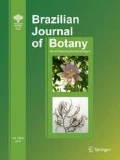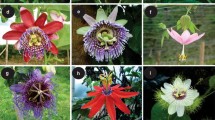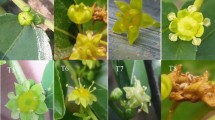Abstract
Many species of wild passion fruit are used for the genetic breeding of passion fruit crop and kept in germplasm banks. This study investigated floral biology, breeding system, and chromosome number of Passiflora species that occur in areas of Cerrado in Uberlândia, Minas Gerais, from 2008 to 2010. In general, the species bloomed in the rainy season, the anthesis was diurnal, except for P. tricuspis, and flowers were open from 6 to 12 h. At the time of flower opening, the nectar was already accumulated in the nectariferous chamber. Protandry occurred only in P. tenuifila. Bees were the main flower visitors of these species. There were significant differences in the diameter and length of the floral androgynophore among species. Passiflora amethystina, P. tenuifila (both subgenus Passiflora), and P. suberosa (subgenus Decaloba) were self-fertile, while P. cincinnata (subgenus Passiflora) and P. tricuspis (subgenus Decaloba) were self-sterile, which contrasted with the usual trends in the group. The chromosome number for P. tricuspis was 2n = 12, P. amethystina and P. tenuifila were 2n = 18 chromosomes, and P. suberosa was 2n = 24 chromosomes, which conformed to the recorded results for the group. Overall conservative chromosome numbers, and self-fertility in P. amethystina are interesting results for breeding programs and basic information for conservation.




Similar content being viewed by others
References
Acioli MF (2003) Ecologia da polinização de Passiflora suberosa Linnaeus (Passifloraceae). Dissertation, Universidade Federal do Rio Grande do Sul Porto Alegre, Brazil
Amela-García MT (2008) Breeding system and related floral features under natural and experimental conditions of Passiflora suberosa (Passifloraceae). Bol Soc Argent Bot 43:83–93
Bellon G, Faleiro FG, Junqueira KP, Junqueira NTV, Santos EC, Braga MF, Guimarães CT (2007) Variabilidade genética de acessos silvestres e comerciais de Passiflora edulis Sims. com base em marcadores RAPD1. Rev Bras Frutic 29:124–127
Benevides CR (2006) Biologia floral e polinização de Passifloraceae Nativas e cultivadas na Região Norte Fluminense-RJ. Dissertation. Universidade Federal Fluminense, Rio de Janeiro, Brazil
Bernacci LC, Meletti LMM, Soares-Scott MD (2003) Maracujá-doce: o autor, a obra e a data da publicação de Passiflora alata (Passifloraceae). Rev Bras Frutic 25:355–356
Bruckner CH, Casali VWD, Moraes CF, Regazzi AJ, Silva EAM (1995) Self-incompatibility in passion fruit (Passiflora edulis Sims). Acta Hortic 370:45–52
Cervi AC (1997) Passifloraceae do Brasil. Estudo do gênero Passiflora L., subgênero Passiflora. Fontqueria 45:1–9
Cervi AC (2006) O gênero Passiflora L. no Brasil, após 1950. Adumbrationes AD Summæ Editionem 16
Cervi AC, Linsingen LV (2008) Sinopse taxonômica das Passifloraceae Juss. no complexo de Cerrado (savana) no estado do Paraná–Brasil. Iheringia (Série Botânica) 63:145–157
Cutri L, Dornelas MC (2012) Passioma: exploring expressed sequence tags during flower development in Passiflora spp. Comp Funct Genomics. doi:10.1155/2012/510549
Damayanti F, Lawn RJ, Bielig LM (2010) Genetic compatibility among domesticated and wild accessions of the tropical tuberous legume Vigna vexillata (L.) A. Rich Crop Pasture Sci 61:785–797
Deginani NB, Escobar A (2002) Números cromossômicos de espécies de Passiflora (Passifloraceae). Hickenia 3:143–144
Dornelas MC, Tavares FCA, Oliveira JC, Vieira MLC (1995) Plant regeneration form protoplast fusion in Passiflora spp. Plant Cell Rep 15:106–110
Escobar LK (1988) Passifloraceae. In Pinto P and Lozano G (eds.), Flora de Colombia, Universidad Nacional de Colombia, Bogota, Colombia, pp 1–138
Faleiro FG, Junqueira NTV, Braga MF (2005) Germoplasma e melhoramento genético do maracujazeiro—Desafios da pesquisa. In: Faleiro FG, Junqueira NTV (eds) Maracujá: germoplasma e melhoramento genético. Planaltina, Embrapa Cerrados, pp 187–210
Faria FS, Stehmann JR (2010) Biologia reprodutiva de Passiflora capsularis L. e P. pohlii Mast. (Decaloba, Passifloraceae). Acta Bot Bras 24:262–269
Guerra M (1983) O uso do Giemsa na citogenética vegetal—comparação entre a coloração simples e o bandeamento. Ciên Cult 35:190–193
Guerra M, Souza MJ (2002) Como observar cromossomos: um guia de técnicas em citogenética vegetal, animal e humana. Ribeirão Preto, Brazil
Guimarães AA (2002) Influência da variação numérica dos nectários extraflorais de Passiflora suberosa Linnaeus (Passifloraceae) na fauna de formicídeos associada. Dissertation. Universidade Federal do Rio Grande do Sul, Porto Alegre, Brazil
Hancock JF (2012) Plant evolution and the origin of crop species, 3rd edn. CABI, Cambridge
Junqueira NTV, Braga MF, Faleiro FG, Peixoto JR, Bernacci LC (2005) Potencial de espécies silvestres de maracujazeiro como fonte de resistência a doenças. In: Faleiro FG, Junqueira NTV, Braga MF (eds) Maracujá: germoplasma e melhoramento genético. Planaltina, Embrapa Cerrados, pp 81–108
Kearns CA, Inouye DW (1993) Techniques for Pollination Biologists. University Press of Colorado, Niwot
Kiill LHP, Siqueira KMM, Araújo FP, Trigo SPM, Feitoza EA, Lemos IB (2010) Biologia reprodutiva de Passiflora cincinnata Mast. (Passifloraceae) na região de Petrolina (Pernambuco, Brazil). Oecol Aust 14:115–127
Killip EP (1938) The American species of Passifloraceae. Field Mus Nat Hist Bot Ser 19:1–613
Koschnitzke C, Sazima M (1997) Biologia floral de cinco espécies de Passiflora L. (Passifloraceae) em mata semidecídua. Rev Bras Bot 20:119–126
Longo JM, Fischer E (2006) Efeito da secreção de néctar sobre a polinização e a produção de sementes em flores de Passiflora speciosa Gardn. (Passifloraceae) no Pantanal. Rev Bras Bot 29:481–488
Mable BK (2004) Polyploidy and self-compatibility: is there an association? New Phytol 162:803–811
MacDougal JM (1994) Revision of Passiflora subgenus Decaloba section Pseudodysosmia (Passifloraceae). Syst Bot Monog 41:1–146
MacDougal JM, Feuillet C (2004) Systematics. In: Ulmer T, MacDougal JM (eds) Passiflora, Passionflowers of the world. Timber, Portland, pp 27–31
Malerbo-Souza DT, Nogueira-Couto RH, Toledo VAA (2002) Insetos associados às flores de diferentes espécies de maracujá (Passiflora spp.). Acta Sci Mar 24:1269–1274
Melo NF, Cervi AC, Guerra M (2001) Karyology and citotaxonomy of the genus (Passiflora spp.). (Passifloraceae). Pl Syst Evol 226:69–84
Mondin CA, Cervi AC, Moreira GRP (2011) Sinopse das espécies de Passiflora L. (Passifloraceae) do Rio Grande do Sul. Brazil Rev Bras Bioc 9:3–27
Morellato LPC, Leitão Filho HF (1996) Reproductive phenology of climbers in a southeastern brazilian forest. Biotropica 28:180–191
Muschner VC, Lorenz AP, Cervi AC, Bonatto SL, Souza-Chies TT, Salzano FM, Freitas LB (2003) A first molecular phylogenetic analysis of Passiflora (Passifloraceae). Amer J Bot 90:1229–1238
Oliveira PE, Gibbs PE (2000) Reproductive biology of woody plants in a cerrado community of the central Brazil. Flora 195:311–329
Rêgo MM, Bruckner CH, Silva EAM, Finger FL, Siqueira DL, Fernandes AA (1999) Self-incompatibility in passion fruit: evidence of two locus genetic control. Theor Appl Genet 98:564–568
Rêgo MM, Rêgo ER, Bruckner CH, Silva EAM, Finger FL, Pereira KJC (2000) Pollen tube behavior in yellow passion fruit following compatible and incompatible crosses. Theor Appl Genet 101:685–689
Rosa R, Lima SC, Assunção WL (1991) Abordagem preliminar das condições climáticas de Uberlândia (MG). Soc Nat 3:91–108
Sandhu S, Blount AR, Quesenberry KH, Altpeter F (2010) Apomixis and ploidy barrier suppress pollen-mediated gene flow in field grown transgenic turf and forage grass (Paspalum notatum Flüggé). Theor Appl Genet 121:919–929
Sazima M, Sazima I (1978) Bat pollination of the passion flower P. mucronata in southeastern Brazil. Biotropica 10:100–109
Sazima I, Sazima M (1989) Mamangavas e irapuãs (Hymenoptera, Apidea): visitas, interações e consequências para a polinização do maracujá (Passifloraceae). Rev Bras Entomol 33:109–118
Silva JR, Oliveira HJ (2001) Implantação da cultura, manejo e tratos culturais. In: Bruckner C, Picanço MC (eds) Maracujá tecnologia de produção, pós-colheita, agroindústria, mercado. Porto Alegre, Editora Cinco Continentes, pp 139–161
Soares-Scott MD, Meletti LM, Bernacci LC, Passos IRS, Faleiro FG, Junqueira NTV, Braga MF (2005) Citogenética clássica e molecular em passifloras. In: Faleiro FG, Junqueira NTV, Braga MF (eds) Maracujá: germoplasma e melhoramento genético. Planaltina, Embrapa Cerrados, pp 213–240
Storti EF (2002) Biologia da polinização e sistema reprodutivo de Passiflora coccinea Aubl. em Manaus, Amazonas. Brasil Acta Amaz 32:421–429
Ulmer T, Macdougal JM (2004) Passiflora: Passionflowers of the world. Timer Press, Inc., Cambridge
Varassin IG, Silva AG (1999) A melitofilia em Passiflora alata Dryander (Passifloraceae), em vegetação de Restinga. Rodriguésia 50:5–17
Varassin IG, Trigo JR, Sazima M (2001) The role of nectar production, flower pigments and odour in the pollination of four species of Passiflora (Passifloraceae) in south eastern Brazil. Bot J Linn Soc 136:139–152
Yotoko KSC, Dornelas MC, Togni PD, Fonseca TC, Salzano FM, Bonatto SL, Freitas LB (2011) Does variation in genome sizes reflect adaptive or neutral processes? New clues from passiflora. PLoS One 6:e18212. doi:10.1371/journal.pone.0018212
Acknowledgments
We thank the Empresa Brasileira de Pesquisas Agropecuárias (EMBRAPA-CERRADOS) for funding the work and internship scholarships awarded to the first two authors, referring to the sub-project: Floral biology and pollination of native passion fruit (Passiflora); the members of the LECA (Laboratório de Ecologia e Comportamento de Abelhas- Universidade Federal de Uberlândia—UFU) for the identification of the species of bees; to Dra. Júlia Yamagishi Costa (UFU) and MSc. Rafaela Cabral Marinho for their help in the cytogenetic analysis and Ms. Isabel to allow studies of species in her backyard.
Author information
Authors and Affiliations
Corresponding author
Rights and permissions
About this article
Cite this article
Duarte, M.O., Alves, M.F., Yamamoto, M. et al. Self-sterility and self-fertility of Passiflora L. (Passifloraceae) in the Cerrado of Central Brazil. Braz. J. Bot 37, 61–68 (2014). https://doi.org/10.1007/s40415-013-0041-2
Received:
Accepted:
Published:
Issue Date:
DOI: https://doi.org/10.1007/s40415-013-0041-2




